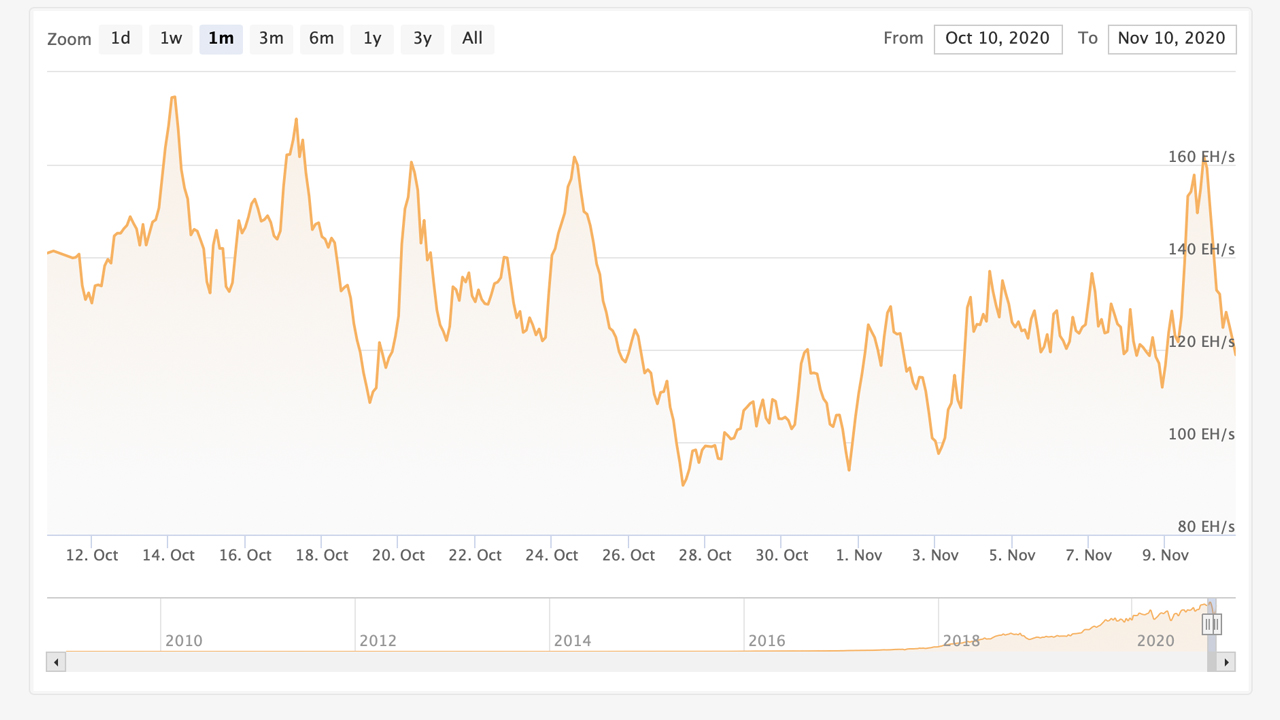
Seven days ago Bitcoin’s network difficulty saw the largest drop in nine years as it slid over 16% last week. Similar to the crypto asset’s price, the hashrate has been extremely volatile according to statistics. After dropping to 111 exahash per second (EH/s), the network hashrate spiked a whopping 45% on Tuesday morning to 161 EH/s before sliding back to 120 EH/s.
Bitcoin’s hashrate, much like the price of bitcoin (BTC), has been jumping around during the last few days. The crypto asset’s hashrate is the measurement of processing power pointed at the network. In 2020, the hashrate had spiked to an all-time high of around 170 EH/s on October 8. At the end of October, BTC’s hashrate slid 40% and a number of speculators claimed it was because of Chinese miners migrating to different locations.
Bitcoin’s hashrate dropped to 90 EH/s on the hourly chart (24h MA) on October 27, 2020. This helped the mining difficulty drop that took place a week ago. When the difficulty drop happened on November 3, the network hashrate was around 97 EH/s.
On Tuesday, November 3, it was also estimated that the network difficulty would drop again and lose another 16%. At the time of publication, that figure has changed, as it’s estimated to see a 10.4% drop (15t) in five days.

Then after hovering above the 100 EH/s mark between 110-125 EH/s, on November 8 a lot of hashpower came online. During the next 48 hours that followed the hashrate increased by 45% until Tuesday morning (Nov. 10) reaching 161 EH/s.
The hashrate on Tuesday, November 10 has already dropped again to 120 EH/s losing 25.46% since the high. Today there are 16 mining pools dedicating hash to the Bitcoin (BTC) network with F2pool capturing 18% or 22.9 EH/s.
At current BTC prices mining is much more profitable than just a few weeks ago and at an electricity cost of around $0.12 per kilowatt-hour (kWh), 24 ASIC mining rigs are profiting. Since the last big hashrate drop coupled with the difficulty drop, block times were slower and transaction fees increased.
Today, data shows the next block fee for BTC is currently $9.25 and the current median fee is roughly $2.87 per transaction. The mempool (transaction queue) however is lighter than it was at the end of October dropping from 121k unconfirmed transactions to only 21k today.
What do you think of the erratic Bitcoin hashrate these days? Let us know what you think about this subject in the comments section below.
Image Credits: Shutterstock, Pixabay, Wiki Commons, Coinwarz.com,
Disclaimer: This article is for informational purposes only. It is not a direct offer or solicitation of an offer to buy or sell, or a recommendation or endorsement of any products, services, or companies. Bitcoin.com does not provide investment, tax, legal, or accounting advice. Neither the company nor the author is responsible, directly or indirectly, for any damage or loss caused or alleged to be caused by or in connection with the use of or reliance on any content, goods or services mentioned in this article.

